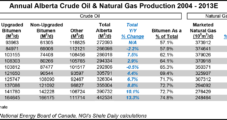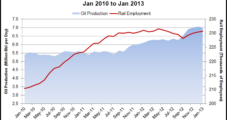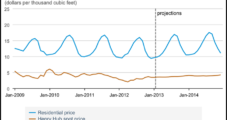Sempra Energy CEO Debra Reed on Thursday outlined the company’s strategy, which is centered around the surge in North American natural gas supplies, particularly from U.S. shale plays. Reed sees opportunity in Mexico, where Sempra already holds a big stake, as that country migrates from oil to natural gas use.
Supplies
Articles from Supplies

Alberta Fracking New Life Into Oil Production
Horizontal drilling and hydraulic fracturing has powered the biggest increase since the 1970s in Alberta oil production from flowing wells outside the northern bitumen sands belt, says the provincial Energy Resources Conservation Board (ERCB).

Tesoro Plans Crude Rail Project to West
In another plan for getting shale-driven domestic crude oil supplies in the central United States to the West Coast, Tesoro Corp. and Savage Companies on Monday formed a joint venture to develop and operate a new rail shipment-linked 120,000 b/d unloading and marine loading facility at Port of Vancouver, WA, across the Columbia River from Portland, OR.
Industry Brief
Pacific Northwest water flows, which can influence summer energy supplies throughout the West, are likely to differ greatly between the northeasterly and southeasterly parts of the four-state and far western Canada region, according to the latest analysis from the Northwest Power and Conservation Council (NPCC). Below-average steam flows can be expected in the Snake River basin and eastern Oregon in the southern part of the Columbia River Basin, but flows are expected to be near or just slightly below normal in the upper Columbia and main Columbia River this spring and summer. “The highest runoff forecast in the basin can be found in the upper Columbia in British Columbia,” NPCC Manager Jim Ruff told the NPCC board. He also concluded that with an only slightly below-normal snowpack as of April 1, it is likely there will be a good summer runoff at near-normal levels in the main Columbia River this spring-summer season. NPCC’s latest analysis follows the Northwest River Forecast Center predicting that river flows for the first seven months this year will be about 89% of normal, and the fact that they are that high is attributable to much higher-than-normal precipitation last fall (see Daily GPI, April 8).
NPCC Watching Northwest Water Levels
Always an important factor in gauging summer energy supplies, particularly for power generation, Pacific Northwest river flows and water levels are getting increased scrutiny this month following an above-normally dry and warm January through March period.
Barclays Lifts Natural Gas Price Projections for 2013
Wintry weather boosted natural gas consumption and has lifted prices, but the trajectory of U.S. supplies largely has remained unchanged, and that means gas prices may “hunt” this year for the right level of gas-to-coal displacement to keep the market balanced, according to an analysis by Barclays Capital.
Not Everyone is Ready to Sign Appalachian Fracking ‘Peace Treaty’
It was billed as a bilateral effort to ensure safe and environmentally responsible development of the Appalachian Basin’s shale gas resources, but not everyone on the environmental side of the aisle is ready to embrace the Center for Sustainable Shale Development (CSSD).
Malfunctioning Carrizo Well Capped in Pennsylvania
Workers brought a malfunctioning natural gas well in Wyoming County, PA, under control on Thursday, according to the state Department of Environmental Protection (DEP).
Industry Brief
A proposal to cut down on flared associated natural gas supplies in the Bakken was rejected by the North Dakota Senate Wednesday on a 34-13 vote. The measure (SB 2315) by Sen. Tim Mathern would have eliminated any hardship exemptions to the state’s ban after a year. Viewed as one of the toughest proposals to combat flaring yet, SB 2315 was strongly opposed by the industry, led by the North Dakota Petroleum Council (see Shale Daily, Feb. 12). State officials increasingly have worried about flaring, which has stayed above 30%, but below a September 2011 record of 36%. Senators opposing the measure urged patience in letting the industry address the problem. Even with the ability to flare gas for a year without paying taxes or royalties, and beyond that to seek hardship status for extending the practice, some operators are trying to find uses for the gas, including using it to produce electricity to run hydraulic fracturing equipment, and to produce fertilizer (see Shale Daily, Dec. 26, 2012).

Wellhead Freeze-Offs Are Supply Disruption Risk — EIA
As U.S. operators move onshore from the offshore, wellhead freeze-offs are becoming a bigger risk to natural gas supplies, the Energy Information Administration (EIA) said Tuesday in the Short-Term Energy Outlook (STEO).




